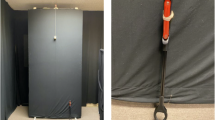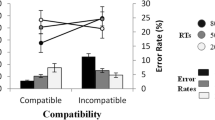Abstract
We examined several factors that affect people’s ability to perceive possibilities for action. In Experiment 1, 24 participants crossed expanses of various sizes in three conditions: leaping, a familiar, launching action system; arm-swinging on monkey bars, an unpracticed skill that uses the arms rather than the legs; and crawling on hands and knees, a disused skill that involves all four limbs. Before and after performing each action, participants gave verbal judgments about the largest gap they could cross. Participants scaled initial judgments to their actual abilities in all three conditions. But they considerably underestimated their abilities for leaping, a launching action, and for arm-swinging when it was performed as a launching action; judgments about crawling, a non-launching action, and arm-swinging when it was performed as a non-launching action were more accurate. Thus, launching actions appear to produce a deficit in perceiving affordances that is not ameliorated by familiarity with the action. However, after performing the actions, participants partially corrected for the deficiency and more accurately judged their abilities for launching actions—suggesting that even brief action experience facilitates the perception of affordances. In Experiment 2, we confirmed that the deficit was due to the launching nature of the leaping and arm-swinging actions in Experiment 1. We asked an additional 12 participants to cross expanses using two non-launching actions using the legs (stepping across an expanse) and the arms (reaching across an expanse). Participants were highly accurate when judging affordances for these actions, supporting launching as the cause of the underestimation reported in Experiment 1.



Similar content being viewed by others
References
Adolph KE (1995) Psychophysical assessment of toddlers’ ability to cope with slopes. J Exp Psychol Hum Percept Perform 21:734–750
Adolph KE (1997) Learning in the development of infant locomotion. Monogr Soc ResChild Dev 62:1–162
Adolph KE, Joh AS (2009) Multiple learning mechanisms in the development of action. In: Woodward A, Needham A (eds) Learning and the infant mind. Oxford University Press, New York, pp 172–207
Adolph KE, Vereijken B, Shrout PE (2003) What changes in infant walking and why. Child Dev 74:474–497
Adolph KE, Tamis-LeMonda CS, Ishak S, Karasik LB, Lobo SA (2008) Locomotor experience and use of social information are posture specific. Dev Psychol 44:1705–1714
Adolph KE, Joh AS, Eppler MA (2010) Infants’ perception of affordances of slopes under high and low friction conditions. J Exp Psychol Hum Percept Perform 36:797–811
Adolph KE, Berger SE, Leo AJ (2011) Developmental continuity? Crawling, cruising, and walking. Dev Sci 14:306–318
Ashby BM, Heegaard JH (2002) Role of arm motion in the standing long jump. J Biomech 35:1631–1637
Bril B, Breniere Y (1989) Steady-state velocity and temporal structure of gait during the first six months of autonomous walking. Hum Mov Sci 8:99–122
Bruhn S, Kullmann N, Gollhofer A (2004) The effects of a sensorimotor training and a strength training on postural stabilisation, maximum isometric contraction and jump performance. Int J Sports Med 25:56–60
Carello C, Grosofsky A, Reichel FD, Solomon HY, Turvey MT (1989) Visually perceiving what is reachable. Ecol Psychol 1:27–54
Castro-Piñero J, Ortega FB, Artero EG, Girela-Rejón MJ, Mora J, Sjöström M, Ruiz JR (2010) Assessing muscular strength in youth: usefulness of standing long jump as a general index of muscular fitness. J Strength Cond Res 24:1810–1817
Comalli DM, Franchak JM, Char A, Adolph KE (2012) Younger and older adults’ perception of affordances for doorways and ledges (Manuscript in preparation)
Fajen BR, Riley MA, Turvey MT (2008) Information, affordances, and the control of action in sport. Int J Sports Psychol 40:70–79
Fath AJ, Fajen BR (2011) Static and dynamic visual information about the size and passability of an aperture. Perception 40:887–904
Franchak JM, Adolph KE (2012a) Gut Estimates: Pregnant women perceive possibilities for walking through doorways (Manuscript in preparation)
Franchak JM, Adolph KE (2012b) What infants know and what they do: Perceiving possibilities for walking through openings. Dev Psychol. doi:10.1037/a0027530 (Advance online publication)
Franchak JM, van der Zalm DJ, Hartzler BM, Adolph KE (2009) Perceiving affordances for navigating through openings. In: International conference on perception and action, Minneapolis, MN
Franchak JM, van der Zalm D, Adolph KE (2010) Learning by doing: action performance facilitates affordance perception. Vision Res 50:2758–2765
Franchak JM, Celano EC, Adolph KE (2012) Perception of passage through openings cannot be explained geometric body dimensions alone (Manuscript in revision)
Gibson JJ (1979) The ecological approach to visual perception. Houghton Mifflin Company, Boston
Higuchi T, Takada H, Matsuura Y, Imanaka K (2004) Visual estimation of spatial requirements for locomotion in novice wheelchair users. J Exp Psychol Appl 10:55–66
Higuchi T, Cinelli ME, Greig MA, Patla AE (2006) Locomotion through apertures when wider space for locomotion is necessary: adaptation to artificially altered bodily states. Exp Brain Res 175:50–59. doi:10.1007/s00221-006-0525-4
Joh AS, Adolph KE (2006) Learning from falling. Child Dev 77:89–102
Joh AS, Adolph KE, Narayanan PJ, Dietz VA (2007) Gauging possibilities for action based on friction underfoot. J Exp Psychol Hum Percept Perform 33:1145–1157
Kinsella-Shaw JM, Shaw R, Turvey MT (1992) Perceiving “walk-on-able” slopes. Ecol Psychol 4:223–239
Konczak J, Meeuwsen HJ, Cress ME (1992) Changing affordances in stair climbing: the perception of maximum climbability in young and older adults. J Exp Psychol Hum Percept Perform 18:691–697
Kretch KS, Adolph KE (in press) No bridge too high: Infants decide whether to cross based on bridge width not drop-off height. Dev Sci
Kretch KS, Adolph KE (2013) Cliff or step? Posture-specific learning at the edge of a drop-off. Child Dev 84:226–240
Loomis JM, Beall AC (1998) Visually controlled locomotion: its dependence on optic flow, three-dimensional space perception, and cognition. Ecol Psychol 10:271–285
Mark LS (1987) Eyeheight-scaled information about affordances: a study of sitting and stair climbing. J Exp Psychol Hum Percept Perform 13:361–370
Mark LS, Baillet JA, Craver KD, Douglas SD, Fox T (1990) What an actor must do in order to perceive the affordance for sitting. Ecol Psychol 2:325–366
Mark LS, Jiang YJ, King SS, Paasche J (1999) The impact of visual exploration on judgements of whether a gap is crossable. J Exp Psychol Hum Percept Perform 25:287–295
Meylan C, McMaster T, Cronin J, Mohammad NI, Rogers C, DeKlerk M (2009) Single-leg lateral, horizontal, and vertical jump assessment: reliability, interrelationships, and ability to predict sprint and change-of-direction performance. J Strength Cond Res 23:1140–1147
Mondschein ER, Adolph KE, Tamis-LeMonda CS (2000) Gender bias in mothers’ expectations about infant crawling. J Exp Child Psychol 77:304–316
Pepping G, Li F (2005) Effects of response task on reaction time and the detection of affordances. Mot Control 9:129–143
Pufall PB, Dunbar C (1992) Perceiving whether or not the world affords stepping onto and over: a developmental study. Ecol Psychol 4:17–38
Ramenzoni VC, Riley MA, Davis TJ, Shockley K, Armstrong R (2008) Tuning into another person’s action capabilities: perceiving maximal jumping-reach height from walking kinematics. J Exp Psychol Hum Percept Perform 34:919–928
Ramenzoni VC, Davis TJ, Riley MA, Shockley K (2010) Perceiving action boundaries: learning effects in perceiving maximum jumping-reach affordances. Atten Percept Psychophys 72:1110–1119
Regia-Corte T, Wagman JB (2008) Perception of affordances for standing on an inclined surface depends on height of center of mass. Exp Brain Res 191:25–35
Schmuckler MA (1996) Development of visually guided locomotion: barrier crossing by toddlers. Ecol Psychol 8:209–236
Snapp-Childs W, Bingham GP (2009) The affordance of barrier crossing in young children exhibits dynamic, not geometric, similarity. Exp Brain Res 198:527–533
Stefanucci JK, Geuss MN (2010) Duck! Scaling the height of a horizontal barrier to body height. Atten Percept Psychophy 72:1338–1349
Stoffregen TA, Yang C, Bardy BG (2005) Affordance judgments and nonlocomotor body movement. Ecol Psychol 17:75–104
Stoffregen TA, Yang C, Giveans MR, Flanagan M, Bardy BG (2009) Movement in the perception of an affordance for wheelchair locomotion. Ecol Psychol 21:1–36
Warren WH (1984) Perceiving affordances: visual guidance of stair climbing. J Exp Psychol Hum Percept Perform 10:683–703
Warren WH, Whang S (1987) Visual guidance of walking through apertures: body-scaled information for affordances. J Exp Psychol Hum Percept Perform 13:371–383
Yu Y, Bardy BG, Stoffregen TA (2011) Influences of head and torso movement before and during affordance perception. J Mot Behav 43:45–53
Zwart R, Ledebt A, Fong BF, de Vries H, Savelsbergh GJP (2005) The affordance of gap crossing in toddlers. Infant Behav Dev 28:145–154
Acknowledgments
The project described was supported by Award Number R37HD033486 from the National Institute of Child Health & Human Development. We thank Danielle Bendicksen for her help in designing procedures, running participants, and coding data. We thank Gregory Murphy and John Franchak for helpful comments on the manuscript.
Author information
Authors and Affiliations
Corresponding author
Rights and permissions
About this article
Cite this article
Cole, W.G., Chan, G.L.Y., Vereijken, B. et al. Perceiving affordances for different motor skills. Exp Brain Res 225, 309–319 (2013). https://doi.org/10.1007/s00221-012-3328-9
Received:
Accepted:
Published:
Issue Date:
DOI: https://doi.org/10.1007/s00221-012-3328-9




